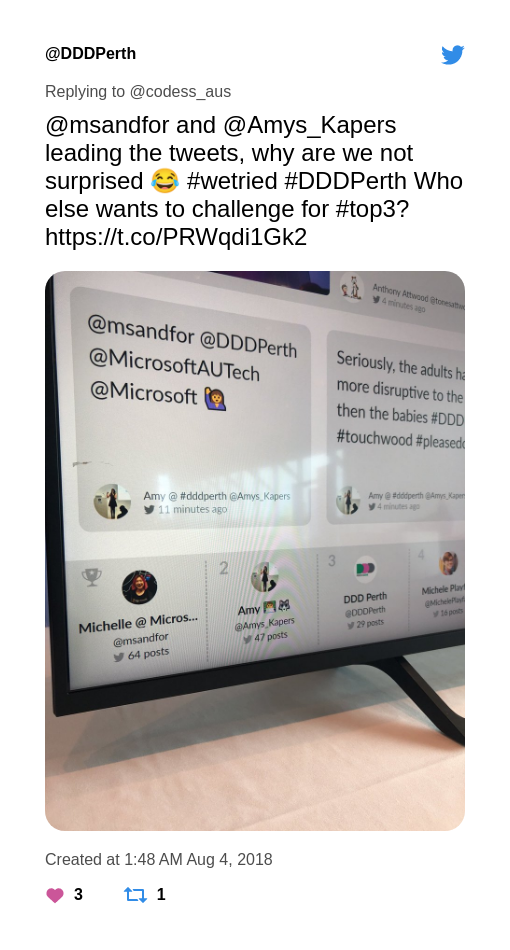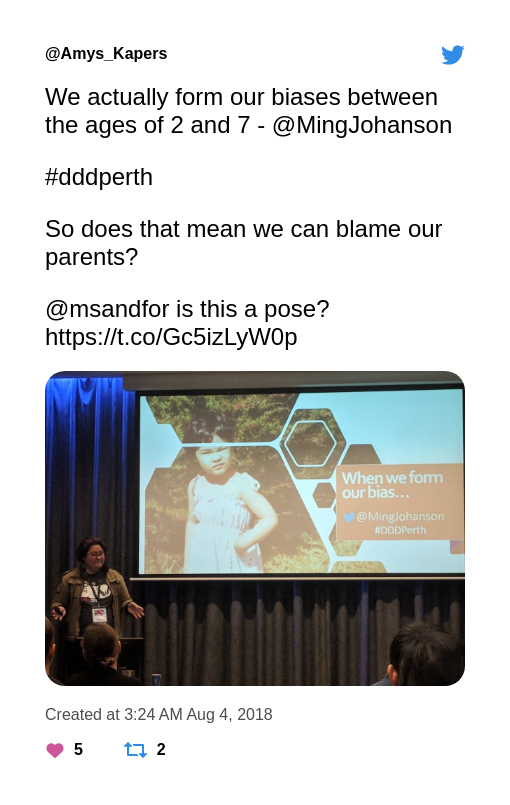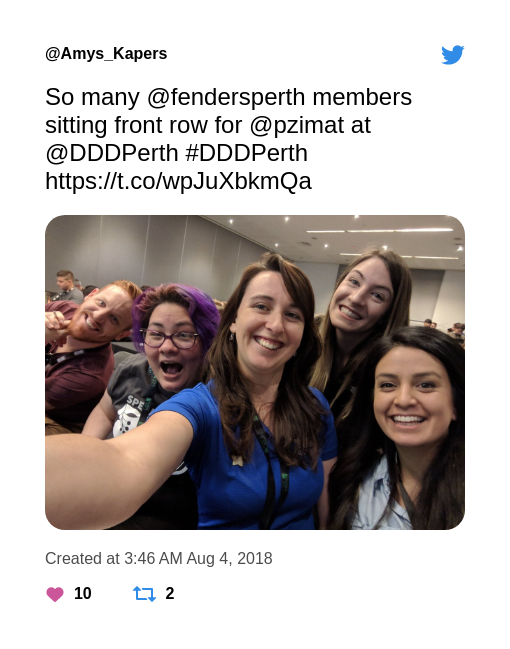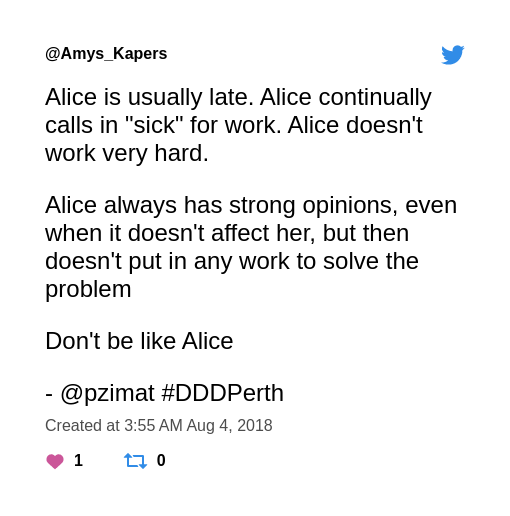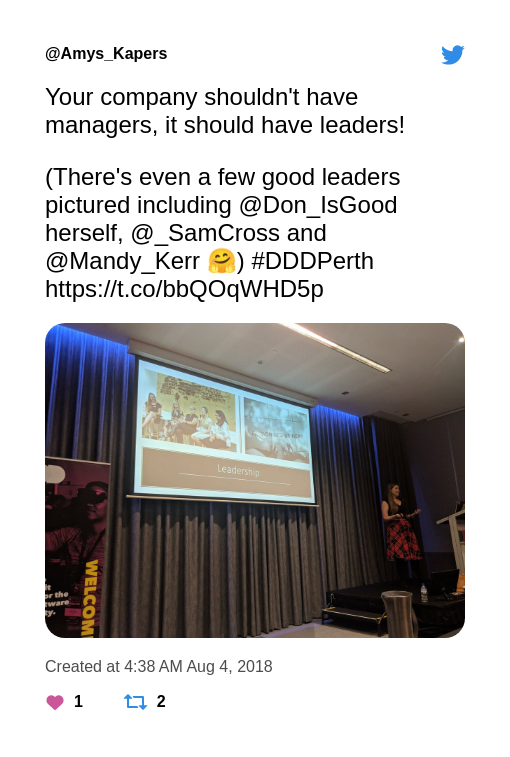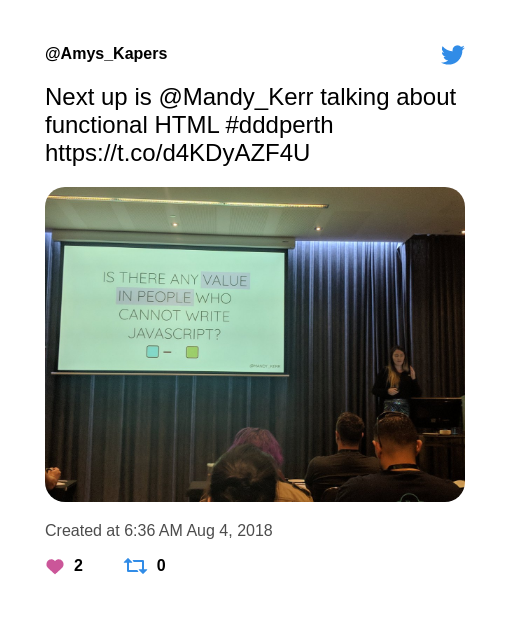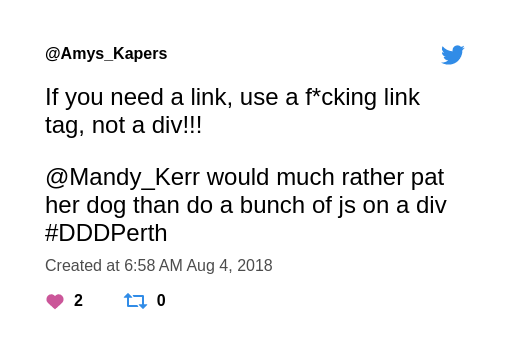DDD Perth 2018
This weekend I got the chance to go to my second DDD conference in Perth, and experience a little of the behind-the-scenes action working on one of the sponsor booths. Having been to my first DDD last year, they’d set the bar pretty high and still managed to not only do better, but smash it out of the park. The team outdid themselves again with more than 50% more attendees than last year (where they’d doubled the year before) and put together an even bigger line-up of talent after receiving over 200 proposal submissions (pretty sure that’s an international record 🎉).
About DDD Perth
This year was DDD’s fourth year in Perth, with each year being bigger and better than the one before (they originally started with 100 attendees, and had over 500 tickets sold this year). Perth’s conference is part of a group of sister events all over the world, all of which give developers free/low cost access to amazing conferences with an open submissions process and a democratically chosen agenda. These conferences are also run on a Saturday so that people can attend without having to take time off work (I mean, who wants to be the person who gets left behind in the office).
This year Perth went a step further and had childcare available on the day for parents to take advantage of. This meant that more parents were able to attend, and the childminding arrangements were as simple as booking childcare when they booked their tickets. I saw some of the activities being organised and they looked pretty awesome, I wouldn’t be surprised if a few adults snuck in to do some crafts. There were also multiple prams spotted around around the venues, and the occupants interrupted less than the adult attendees. It was great to see this inclusion, and there were multiple tweets and mentions throughout the day about how nice the inclusion was.
Last year I was impressed by the quality of conference the team were able to put together at just $50 a ticket, and this year they somehow managed to do even better! With a bigger line-up, more keynotes, a bigger and better venue, better food, more coffee and more stuff to do at the afterparty. This time we were in the upstairs ballroom (to fit all of the people who sold out the conference), with plenty of room outside to mingle and check out the sponsors displays (there was some pretty cool tech on display). This also gave a great view of Elizabeth Quay with several rainbows during the day, and some impressive lights at night.
This year the conference expanded to have four tracks (making it even more difficult which one to choose) and a lunch-note. Unfortunately I was working throughout the day so didn’t get to watch everything, but the talks I did get to see were next level quality and covered really important topics, both technical and non-technical.
To keep track of what was going on throughout the day, they also set up a tweet wall near the registration desk. This gave everyone the chance to see what others were tweeting about and provide a little health competition to get on the leaderboard. Unsurprisingly Michelle was well out in front for the whole day (and even scheduled tweets during her talk so she didn’t lose her place), but I managed to keep my place in second throughout the entire day. Even DDD Perth didn’t manage to overtake us, but they did finish in third place (although with only half as many tweets as Michelle). It was a group effort but we even managed to get #dddperth trending in Perth by the end of the opening keynote and in Australia by the end of the day!
Towards a welcoming Web - Karolina Szczur
Starting off the day on an inspiring note, Karolina joined us from Melbourne to discuss the state of the web today and what we can do to make it a nicer place for everyone. Most people know that the web isn’t all cat gifs and roses, but some of the statistics on sexual harassment and online bullying were a little scary, and the knowledge that Health Engine actually altered reviews to only include the positive sections.
Until anyone, no matter their background, will be able to survive and thrive and be represented online, the Web won’t be open.
Technology and the web can be an incredible help and can make our lives easier, but we still end up building our own biases and prejudices into the technology. We need to make sure we take ownership for building in these systemic flaws and make technology that can help us and then get out of the way.
Karolina touched on a variety of points for making sure that we’re building ethical tech, making sure we’re protecting the most vulnerable online and thinking twice about collecting and storing data we don’t really need.
If our systems aren’t effectively and actively fighting exclusion, you’re helping it. Doing nothing still reinforces exclusion.
Fixing the web isn’t going to be easy, and we’re all going to have to work together to get it done.
What to do with our unconscious bias - Ming Johanson
I’ve seen Ming talk previously, and she does a fantastic job of talking about hard topics. This time she talked about biases, in particular our unconscious ones. We form our unconscious biases between the ages of 2 and 7, and we’re heavily influenced by those around us (and not necessarily those particularly close to us.
Growing up as an Asian woman in Australia, Ming experienced some horrible biases from those around her, politicians and managers. Even after she was turned down for a management role for being too “bubbly” (you know, being too good with people, in a people-centric role), it took a while before she realised that she was having her own unconscious biases formed by others.
While unfortunately there isn’t much we can do to change some people’s biases, Ming talked about the importance of having good people in our lives. These people should challenge you biases in a positive way, and be there for you to talk to. This was a point in the talk where she also shouted out a lot of love for fellow community member (and DDD speaker) Michelle Sandford for being there to challenge her biases and to give a safe space.
We all have our own biases, developed from our upbringings, experiences and privileges. We can’t help this, so make sure you cut yourself a break. But you can make a difference by making your biases conscious and manage them. You can also create relationships with people who help to challenge your bias (in a good way), and who you can do the same for.
We need to stop blaming, ignoring and finding fault in our lives, but instead own up and take responsibility for our actions and for what happens in our lives. Remember that others don’t have the same experiences as you, and like you they don’t have control over their unconscious biases. Instead you can be a person to help them challenge their biases.
Toxic Developers and You - Patrik Affentranger
It was exciting to get to see Patrik give his first conference talk (as a fellow member of the Fenders community), and to see so much local support for him (although a few people looked at how many team members were in the room and questioned who the toxic dev was) with standing room only (and at least one person sitting on the floor).
We’ve all worked with someone who is at least a little toxic, but what actually makes them so? Patrik started off by listing traits associated with toxic developers, they don’t necessarily mean you’re toxic but if you have several traits you might want to reassess a few things.
Remember just because someone is difficult, doesn’t necessarily mean that they’re toxic. Toxic devs make us feel like we don’t know what we’re talking about. They make us anxious, affect our sleep, make us doubt ourselves and can make us paranoid. Working with toxic devs can negatively impact our work, our motivation and our productivity.
If you’re a manager, a toxic dev is likely affecting your team (and not in a good way). And even if you’re not a toxic dev, you might be enabling one. Do you self sacrifice to make up for a toxic dev? You’re probably enabling one.
So make sure to challenge toxic behaviours; for example if someone just continually points out flaws in a code review, get them to provide answers as well.
How can we fix that? What would you do differently?
And remember, people might be going through some other shit in their life, so they may not be toxic, they may just have something going on.
Creating a ‘best place to work’ culture - Donna Edwards
The work that Donna has done to make both the Perth community and her workplace better is incredible and so it’s not really a surprise that she led her work to win the “Best Place to Work” award multiple years running. She talked about the difference between a manager and a leader, and why it’s better for your company to have the latter.
Talking about the importance of emotional intelligence and actually grooming those in your team to one day replace you, it’s no wonder that Donna has managed to get most of her friends to come and work with her, it definite;y sounds like an awesome place to work.
In a world where companies are trying to convince staff to spend all their time at work and forget about their social lives, hearing Donna encourage managers to help their teams build their own personal branding was a nice change, and reminding us that we all need to chip in to fix the diversity problem by not ignoring even the little things (like asking the woman in the room to take the notes). Also the idea that flexible working arrangements shouldn’t just be for parents, working for myself I can give myself the flexibility and I’m getting more done now in less time than when I was working a 9-5.
To finish up, Donna encouraged everyone to make it easier for teams to have the difficult conversations, whether that be about pay rises, promotions, personal development or anything else that your team considers important and would make a difference to their work ethic and daily happiness.
Functional HTML - Mandy Michael
It was super interesting to see Mandy’s talk, as I did a similar one recently (we didn’t plan it, we just happened to both have the same idea separately (kinda like Leibniz and Newton :D ).
Mandy talked about the issue prevelant in the industry today, where there isn’t much value placed in front end developers who can’t write JavaScript. HTML is still changing quite a lot, and good semantic functional HTML is really important for your site to be used by a wide variety of software and devices like your Google Home and many reading apps like Pocket and Apple Reader.
Using her gorgeous dog as an example through most of her slides, Mandy demonstrated using a screen reader on a page that used semantic elements and on a page that just used divs hacked to perform as other elements. If anyone in the audience didn’t realise it before, they knew then what a horrible experience unsemantic HTML gives to anyone using a screen reader or assistive technology.
When we don’t give semantic cues in our web content, people using assistive technology will likely get stuck in a huge block of content, or worse leave
With the HTML standards that we have today, there is no need for us to reinvent the wheel, and there’s probably an element out there that would suit our needs, and will do a lot of the work on functionality and styling with us.
To finish off the talk, Mandy delved into the mysterious world of metadata and gave examples of the additional attributes we should be using to give context to technology about our content. For example, when you’re writing an article, make sure to define where you’ve listed the author so readers like Pocket know what the information is that you’re giving.
HTML is like that amazing friend who we don’t appreciate and who leaves us
Giving every one of us something to take away, Mandy reminded us all of the importance of writing functional HTML, and why we need to respect those who don’t know JavaScript (or at least know that it’s not always the answer).
